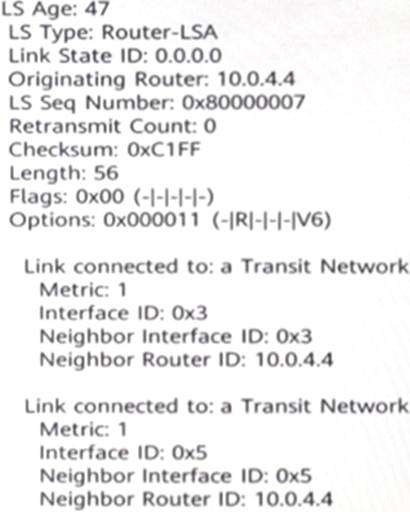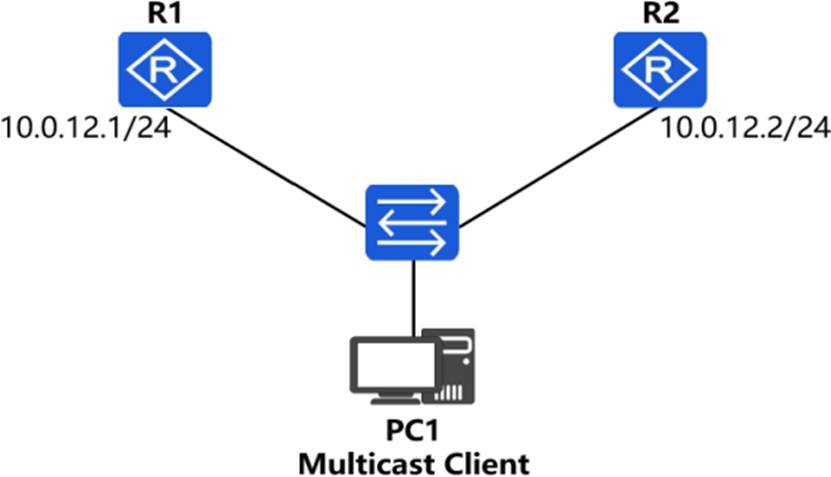Practice Free H12-831_V1.0-ENU Exam Online Questions
In the OSPFv3 network shown in the figure, the interconnected ports of R1, R2, and R3 have OSPFv3 enabled, and the Router ID of each device is 10.0.X.X, where x is the device number. Check the detailed information of a certain LSA on R3, and you can infer from the output information that R1 and R2 are DRs in the network.

- A . True
- B . False
ULA aggregation can be implemented within a physical network by isolating broadcast domains with multiple Sub-LANs and aggregating these Sub-LANs into a logical Super-LAN.
Which of the following descriptions about WAN combinations is correct?
- A . When configuring VLAN aggregation, you can configure VLAN1 as a Super-VLAN
- B . If Proxy ARP is enabled on the VLANIF interface to which the Super-VLAN belongs, all Sub-VLANs can establish corresponding ARP entries for intercommunication.
- C . If the core switch creates a Super-LAN and the corresponding VLANIF interface, then as long as there is a physical interface in the core switch that is Up, the ANIF interface status will be Up.
- D . If different Sub-VLANs belong to the same Super-VLAN, the hosts in these Sub-VLANs can directly communicate at Layer 2
The Router ID of R1 is 10.0.1.1. In the LSDB of R1, the LSA shown in the figure is seen. The network engineer makes the following inferences based on the LSA.

Which one is wrong?
- A . The router that generates the LSA does not support importing external routes into OSPFv3
- B . The router that generates the LSA has at least two interfaces with OSPFv3 enabled
- C . This LSA is not generated by R1
- D . The router that generates this LSA will not generate a Network-LSA
As shown in the figure, when a network engineer is troubleshooting, he draws a schematic diagram of a multicast network. The IGIP version enabled by R1 and R2 is 2, PIM-SM is used as the multicast routing protocol, and other configurations are default configurations. The querier in the multicast network is ().

The LSP fast diffusion feature can speed up the diffusion of LSP. Under normal circumstances, when IS-IS receives an LSP from another router, if this LSP is newer than the corresponding LSP in the local LSDB, it updates the LSP in the LSDB and uses a timer to periodically diffuse the updated LSP in the LSDB. When a device with the LSP fast diffusion feature enabled receives one or more newer LSPs, it diffuses LSPs less than the specified number before route calculation to speed up the synchronization process of the LSDB.
- A . True
- B . False
When the device logs in to other devices as an SSH client and fails to log in using public key authentication, which of the following are possible reasons? (Multiple choice)
- A . The user public key stored on the server is wrong
- B . The client does not enable the first authentication function
- C . Missing local key pair
- D . The server private key saved on the client is wrong
An enterprise network is shown in the figure. If CE2 is dual-owned by PE2 and PE3, a Type 5 LSA routing loop may occur. The loop can be prevented by setting the route-tag command on PE2 and PE3 devices. When the Route Tag of the route received by PE3 is the same as the local configuration, the route will be ignored.

- A . True
- B . False
MPLS supports carrying multiple network protocol services, including unicast IPv4 services, multicast IPv4 services, unicast IPv6 services, multicast IPv6 services, etc.
- A . True
- B . False
MP-BGP adds a new path attribute MP_REACH_NLRI to publish VPNv4 routing information or withdraw unreachable routes in BGP/MPLS IP VPN networks
- A . True
- B . False
In order to publish the external routes introduced by the NSSA area to other areas, the Type 7 LSA needs to be converted into a Type 5 LSA so that it can be announced in the entire OSPF network. By default, the router that performs LSA conversion is the area border router (ABR) with the largest router ID in the NSSA area.
- A . True
- B . False
